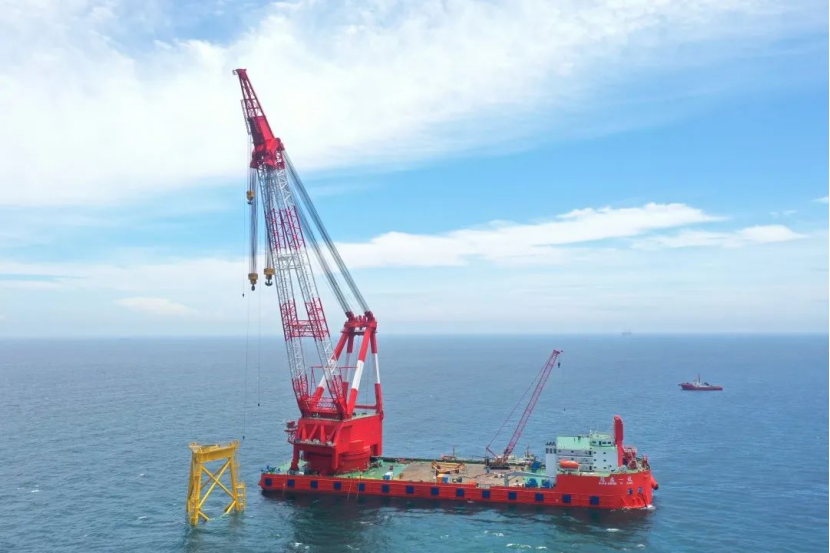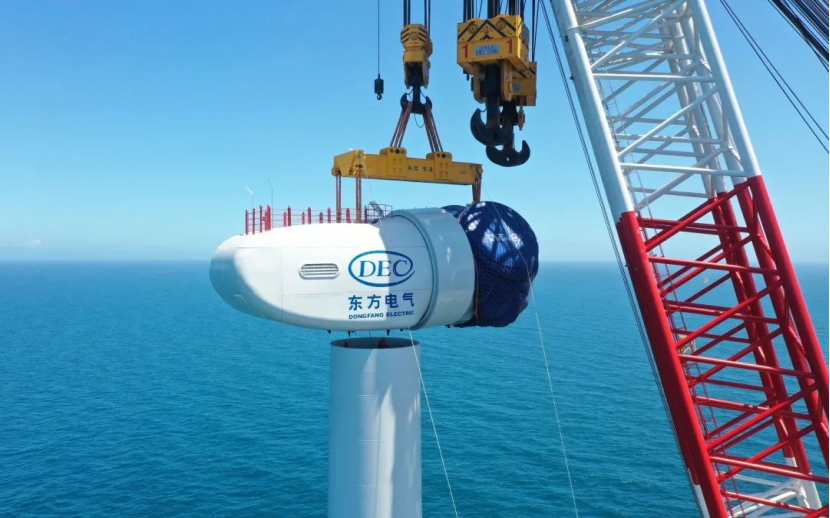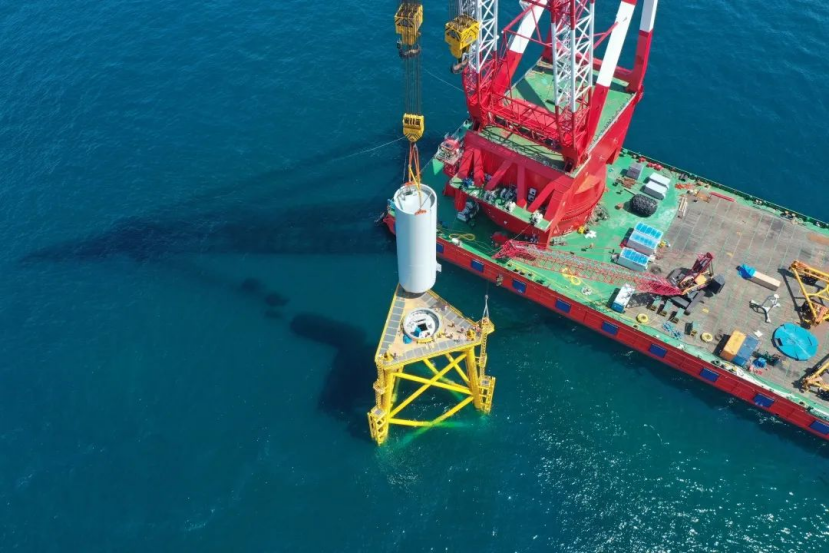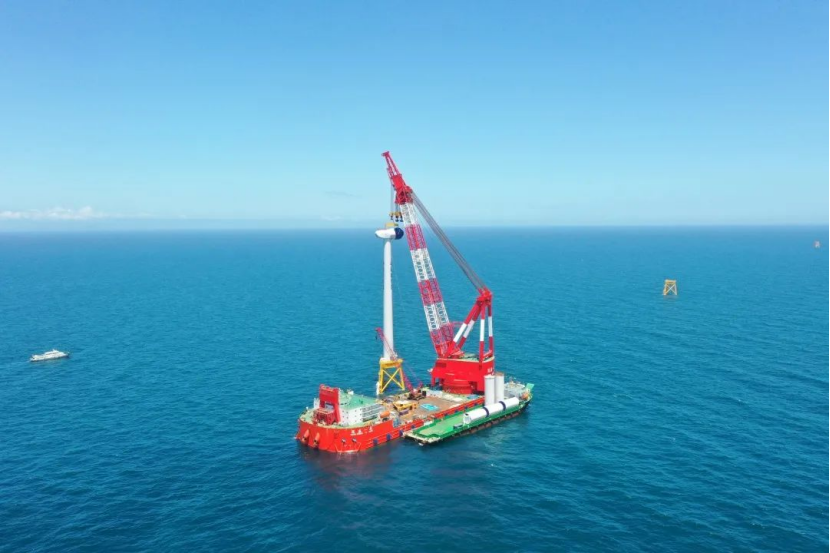Company News
BackFloating installation of 100-meter wind turbines
Our company participated in the construction of the Fujian Offshore Wind Farm Zone C project, which involves the installation of 41 wind turbine foundations and turbines. The water depth in the construction area exceeds 40 meters, making it the deepest offshore wind power project under construction in China.
Among them, the 10 MW wind turbine has a nacelle center height of 120 meters and weighs approximately 510 tons. The nacelle lifting operation falls under the category of heavy-load, ultra-high-altitude, and ultra-high-precision installation in deep offshore waters, imposing extremely stringent requirements on sea conditions. This presents a major challenge that the project team must overcome.
Traditionally, jack-up vessels are used for wind turbine installation. These vessels deploy four legs that embed into the seabed, creating a stable working platform that allows turbine lifting operations to proceed unaffected by waves. However, due to the booming offshore wind power market, vessel resources have become increasingly scarce, and few ships can meet the 40+ meter deep-water operation requirements.
Without long-legged jack-up vessels, floating crane vessels were employed as an alternative.Here, floating installation refers to crane vessels performing turbine installation while floating on the sea surface under favorable sea conditions. However, China's previous experience with floating installations was limited to waters around 10 meters deep—no precedent existed for 40-meter-deep operations. 
"Guansheng Yihang" Crane Ship
The technical team first turned their attention to the “Guansheng Yihang”, a crane vessel still under construction at the time. To meet the demands of floating operations, they optimized the ship's design in multiple aspects, including the crane boom structure, hull configuration, and deck loading capacity.
Key modifications included:
1. Increasing the lifting height from 125 meters to 145 meters, making it the highest-hooking crane vessel in China (measured from the main deck).
2.Boosting lifting capacity by 1,400 tons, enabling it to handle the heaviest nacelles of domestically designed wind turbines.
3.Enlarging the hull to resist strong winds and currents—final dimensions reached 168.5 meters in length and 51.8 meters in width.
4.Reinforcing stability with a double-layer hull structure and ballast system, significantly enhancing safety during lifting operations.
These upgrades transformed the “Guansheng Yihang” into a pioneering vessel capable of floating installations in 40-meter-deep waters, setting a new benchmark for China’s offshore wind industry.  Positioning for Nacelle Installation
Positioning for Nacelle Installation
Moreover, the team tackled critical challenges in floating installation techniques—the most difficult being the precise alignment of the nacelle with the top tower section. To address this, they developed innovative flexible towing assistance measures:
1. Multi-Cable Stabilization
- Multiple ropes were secured to the nacelle’s base.
- Workers (equipped with safety gear) positioned on the top tower section pulled the cables opposite to the nacelle’s sway, minimizing oscillations during lifting.
2. High-Strength Precision Guide Pins
- A steel pin, welded to the nacelle’s base, acted as a "key" for alignment.
- Successful insertion of the pin into the tower’s pre-set interface meant 90% of the installation was complete, ensuring millimeter-level accuracy.
This dual approach reduced reliance on perfect sea conditions and set a first-of-its-kind methodology for deepwater floating installations in China’s offshore wind sector.  Installation of the First Section of the Tower Cylinder
Installation of the First Section of the Tower Cylinder
August 26th: A Trial by Sea
The “Guansheng Yihang” embarked on its first floating nacelle installation. Despite meticulous preparations, the operation faced hidden challenges:
- Lower tower sections (4 segments) were installed smoothly.
- As the 510-ton nacelle was hoisted, invisible currents caused over 1 meter of sway, preventing the guide pin from aligning.
- After over an hour of attempts, the team suspended the mission.
Nighttime Innovation
Under the vessel’s floodlights, engineers analyzed footage frame-by-frame and devised a two-phase solution:
1. Coarse Alignment: A newly designed larger-contact guide device would first stabilize the nacelle.
2. Precision Fit: The original high-strength guide pin would then ensure millimeter accuracy.
The team worked overnight to fabricate and install the new component.
Triumph at Dawn
The next day, leveraging dual guides + drone-assisted real-time sway monitoring, the crew:
- Timed the lift with the nacelle’s most stable swing phase.
- Embedded the coarse guide flawlessly, then micro-adjusted the angle during descent.
- Achieved perfect pin insertion, completing China’s deepest floating nacelle installation with precision.
“Down, down, DOWN!” — The hoist operator’s raspy command marked a historic breakthrough. 
The installation of the nacelle is completed
The roar of celebratory cannons was drowned out by the crew’s cheers—China had just achieved its first successful floating installation of a large-capacity wind turbine in open seas.


